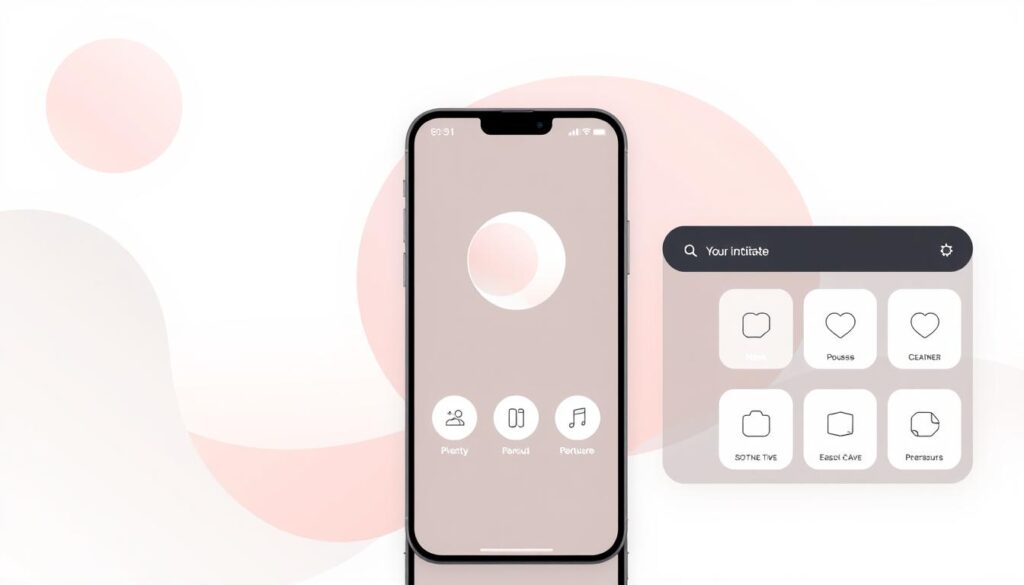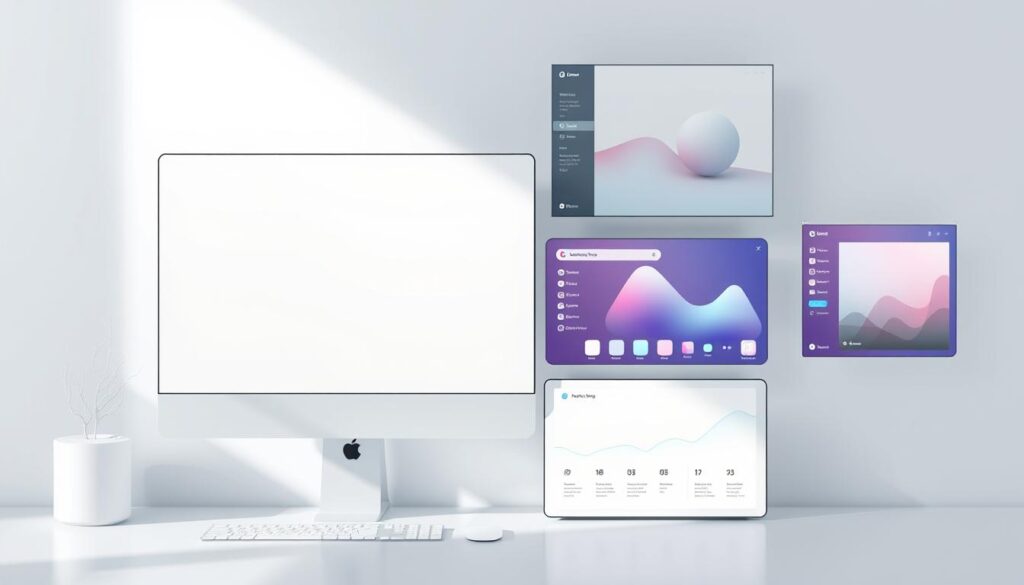Minimalism UI design is transforming the digital world. It focuses on making interfaces simple and easy to use. By removing extra stuff, it makes websites and apps more fun and easy to navigate.
The idea of minimalism UI started with visual art after World War II. It was inspired by the Bauhaus school. Now, big tech names like Google and Apple use it. They show how it can make users happier and more engaged.
Research finds that simple designs can increase website visits by up to 94% with the right images. This style not only looks good but also loads faster and works better on all devices. Minimalism UI design is changing how we use digital platforms for the better.
What Is Minimalism UI Design?
Minimalist UI design focuses on simplicity and functionality in user interfaces. Rooted in architectural and art movements like Bauhaus, it values clean lines and purposeful design. Big tech companies like Google and Apple use this approach to create happier, more engaged users.
Research shows that simple designs can boost website visits by up to 94% with the right images. This style not only looks appealing but also improves performance by loading faster and working seamlessly across devices. At its core, minimalist UI design eliminates unnecessary elements, leveraging white space to create elegance and focus. Its simple color schemes and carefully chosen typography contribute to a cohesive, classy look.
Beyond aesthetics, minimalism in web design enhances user experience by improving navigation and reducing confusion. It ensures websites and apps load quickly, keeping users engaged. Minimalist principles prioritize clarity and remove distractions, allowing important content to shine.
As technology evolves, minimalist UI design evolves with it, incorporating new features while maintaining its commitment to simplicity and functionality.
The Benefits of Minimalism in UI Design
Minimalism in UI design brings many benefits for users and developers. It makes interfaces simple, leading to easy navigation. This simplicity helps users do tasks faster and feel more satisfied.
Minimalist design focuses on what’s essential, making things look better and work better. It shows off the main content and features. This design style can make websites and apps more appealing and engaging.
It also makes websites easier for everyone to use. The simple layouts help users with different abilities. This design also meets Google’s standards for clear and organized content, which can help with SEO.
From a business standpoint, minimalist UI design is cost-effective. It has fewer parts to keep up with, saving money in the long run. These designs also look the same on all devices, keeping the brand’s image consistent.
Elements of Minimalism UI
Minimalism UI design focuses on simplicity and functionality. It emphasizes clean, user-friendly interfaces that enhance both aesthetics and usability.
- Simplicity and Function – Prioritize simplicity and practical usability.
- Clean Layout – Organized structure with ample empty space to guide user focus.
- Simple Colors – Use a limited color palette, often just one or two colors, for a sleek appearance.
- Typography – Easy-to-read fonts used sparingly to highlight content.
- Simple and Clear Icons – Intuitive icons to facilitate navigation.
- Flat Design – Avoid shadows and textures, focusing on a clean, modern appearance.
- White Space – Ample space ensures clarity and readability.
- Subtle Animations and Videos – Used thoughtfully to enhance the user experience without compromising simplicity.
Comparing Minimalism and Other Design Approaches
Minimalism is a standout in UI design, focusing on simplicity and user experience. It’s different from maximalism, which loves abundance. Minimalism removes unnecessary elements, creating clean and focused interfaces.
After World War II, minimalism became popular as a calm response to chaotic art.
Minimalism and flat design are similar but not the same. Designers commonly use flat design in minimalist designs. Minimalism’s strength comes from simplifying and focusing on what matters most. This makes designs timeless and different from busy ones.
Today, with so much information around, minimalist UI design is a breath of fresh air. It improves user experiences by focusing on what’s important. Companies like Apple and Google use minimalism in their products.
For example, Apple’s iOS is all about simplicity and making things easy to use.
On the other hand, platforms like WeChat use a maximalist approach. They combine many features in a rich, visual interface. This style is more common in Eastern cultures, while minimalism is popular in the West. The choice depends on what users need and what the product aims to achieve.
Minimalism in Practice: Successful Examples
Since the 1960s, minimalism in user interface design has become very popular. Tech giants like Apple and Google use minimalist designs in their products. Apple’s iOS is famous for its clean look and consistent fonts.
Their calculator app is a great example of minimalism in action. Google’s Material Design also focuses on simplicity. It uses a grid layout to make everything easy to use on any device.
Airbnb’s website is another example of successful minimalism. It shows only the most important information and visuals. This makes it easy for users to find and book places to stay.
These examples show the benefits of minimalism in design. It makes websites load faster and work better on different screens. Brands like Apple and Google have made their interfaces both beautiful and useful.

Key Considerations When Designing With Minimalism
Minimalism in UI design is more than just removing elements. It’s about making an interface clean and improving user experience. Knowing your audience well is key. This way, you can make your design both beautiful and useful.
Having an easy-to-use navigation is essential in minimalist design. By focusing on what’s most important, you help users move through the interface easily. Research shows that simple designs are better for users because they’re less confusing.
Don’t forget about accessibility in your quest for simplicity. It’s important to test your design with different users to make sure it works for everyone. Users judge your design in just 50 milliseconds. Staying away from common mistakes helps make your design smooth.
Using whitespace well makes your design easier to read and navigate. A clear layout helps users find what they need quickly. By keeping these points in mind, you can make a minimalist UI that looks great and works well.

Tools and Resources for Minimalism UI Design
Designers have many tools to make clean layouts. Adobe XD and Sketch are top choices for user interface design. They help create sleek, minimalist interfaces that grab users’ attention.
For inspiration, check out Dribbble and Behance. They have amazing examples of minimalist UI. Designers can find new ideas and keep up with trends here. Online communities also offer feedback and help improve designs.
Justinmind’s smart guides and grids are key for precise layouts. They ensure perfect alignment, which is essential for minimalist design. User testing tools are also crucial. They check if your design really improves the user experience.
Figma and InVision are great for prototyping and making interactive mockups. Balsamiq and Lucidchart are simple yet effective for wireframing. These tools help create easy-to-use navigation flows, vital for minimalist interfaces.
Choosing the right tools can make your work easier. They let you focus on making designs that are both beautiful and useful. With these tools, you can create standout minimalist UIs in the digital world.
Minimalism UI in Different Industries
Minimalism UI design is popular in many fields. It works well in e-commerce, making it easy to show off products and buy them. Studies show that sites with simple designs get 15% more sales than busy ones.
In education, minimalism helps by cutting down on distractions. This lets students focus better. It’s also good for healthcare apps, making it easier to understand complex info.
Users do not just like minimalist designs. They also keep people on websites longer, with a 35% drop in bounce rates. The demand for UI/UX designers who know about minimalism has grown by 20% in two years.
Companies that use minimalist designs see a 27% jump in user interest in six months. These designs also make websites load faster, by 42% on average. Designers often use minimalism to create an effective user flow for mobile apps, making users happier and apps work better.
Trends Shaping Minimalism UI Design
Minimalism UI design is always changing to meet new user needs and tech advancements. A big trend is focusing on sustainability. Designers make interfaces that use less energy and reduce digital waste.
This approach fits well with minimalism’s values and helps the environment. It’s a win-win for both users and the planet.
Dark mode options are becoming more popular in minimalist designs. They make things easier to see in the dark and save battery life. This is great for people who use their devices a lot.
Subtle motion and animation are now part of minimalist UIs. They add depth and make things more interactive. But they do it without making things too busy.
Flat design is still a key part of minimalism. It uses simple, two-dimensional visuals and avoids gradients. This makes interfaces clean and easy to use.
Grid systems are also becoming more common in minimalist designs. They help organize content in a neat way. This makes things easier to find and use, improving the overall experience.
Common Mistakes To Avoid in Minimalist UI
Minimalist UI design aims to make things easy to use and look good. But, designers often make mistakes that mess up these goals. One big mistake is making things too simple, hiding important features for a clean look. This can make users less engaged by 10-15%.
Finding the right balance is essential. It keeps things functional while still being minimalist.
Another mistake is ignoring what users say. Designers might focus too much on how things look, forgetting what users need. This can drop conversion rates by 20-25% because the design is hard to follow.
Regular testing with users is key to avoiding this. It helps keep the design user-friendly.
Bad layouts can confuse users, ruining the simplicity of minimalist designs. Too much white space can make pages feel empty, dropping engagement by up to 30%. But, using white space well can cut clutter by 40% without losing important stuff.
By avoiding these mistakes, designers can make minimalist UIs that really improve user experience and meet their design goals.
The Future of Minimalism UI Design
The future of minimalism in user interface design is looking bright. Simple design will keep evolving, combining with new tech for better user experiences. Clean, simple interfaces will remain popular, with 53% of users spending time above the fold on webpages, Google says.
Personalization is a big trend in minimalist UI design. HubSpot found users prefer personalized info 2.6 times more. This will lead designers to make minimalist interfaces that fit each user’s needs while staying simple. Accessibility will also be key, with over 15% of the world’s population having disabilities.
Voice-based interfaces and virtual reality will change how we interact with designs. These technologies will make user experiences more natural and immersive. As we move towards 2024, designers will need to keep minimalism alive while using these new tools and meeting user needs.
Embrace Simplicity: The Power of Minimalist UI Design
Minimalist UI design is all about keeping things simple, clean, and functional. By focusing on what really matters, it creates interfaces that are easy to use, visually appealing, and free of distractions.
This approach not only improves the user experience but also gives your design a modern, timeless feel that users genuinely appreciate. Sometimes, less really is more.
Minimalism in UI design goes beyond clean layouts — it’s about creating intuitive, focused experiences that truly connect with users.
If you’re inspired to take your designs to the next level, explore more in-depth tips and strategies on Mood Joy.
From mastering simplicity to balancing aesthetics and functionality, there’s so much to discover. Keep your creative momentum going and transform the way you design!



